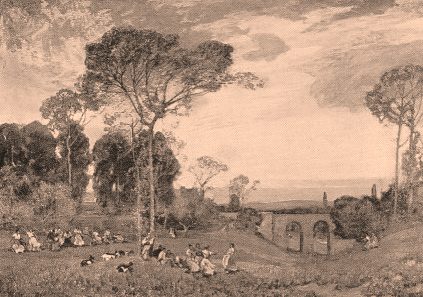
energy is misspent. Curb your impatience to get at your picture; I know it requires an effort to do so, but believe me, the wider your knowledge of your subject prior to painting it on your canvas, the greater are the probabilities of success. I would almost go as far as to say that you should know it well enough to paint it from memory, but that would obviously be travelling beyond the range of painting direct from Nature. The advantage of painting from Nature is that you gain confidence. Confidence comes of knowledge, and that means spontaneity, one of the qualities which can be worth nothing if it is not obtained by intense consciousness.
You have now, we will suppose, your six-footer covered-never mind how roughly or how broadly, as long as you have correctly laid in your values. I do not know if it is necessary to explain what I mean by values. As we use the term in art, it means the truth of one tone in relation to another as compared with Nature. For example, if I pitch my picture as near as I can to the pitch of Nature, and paint one passage exactly of the same intensity or tone as the same passage in Nature, I have struck the key, as it were, in which my tune must be played. I can, of course, transpose it by striking a new key. I can paint the passage I speak of in a lower tone, but all the other tones in the picture must be lowered in the same relation to one another as they are in Nature. For instance, I call the pitch of Nature "A." Say that in Nature it is lowing sunlight, and that it is impossible for any pigment to reach so high a key of colour, I am forced to lower my key to "F". In Nature all colours are in relation to " A," and in my picture, in which the "A" has been reduced to "F", all my tones must, of course, be in relation to " F." If there is 40 per cent. difference between the light and shade in Nature, there must be 40 per cent. difference between the light and shade of my picture, no matter what the pitch of my picture may be.
At this moment, do not concern yourself with finish; you have meanwhile presented your subject in its simplest proportions. If it has been expressed in a high key (and I should always advise your doing so), the various masses of colour should be in exact relation, and the resulting harmony gives the quality of tone. Step back fifty or sixty paces from your canvas, and you will be pleasantly surprised to find (if these conditions which I insist on be observed) how like Nature it is, for the distance in diminishing its size has made you unaware of the absence of details. Your picture should now wait till it is dry. You have, I hope, painted it with a generous brush, and very little, if any, medium-. You have put on the paint with due regard to the texture of the material before you, and in order to prevent cracking, two courses are open to you-either follow the method as described, or continue your picture while it is wet, which is the more difficult to do.
The danger of cracking arises generally from the super- imposition of fresh colour upon a tacky or half-dried surface, more particularly in the case of a fast-drying paint over a slow one. The fault of cracking is not caused by the inferiority of paint or of medium, but by carelessness or indifference in the actual process of painting. The safest way, when painting a large picture from Nature, is to let it dry thoroughly after you have finished the laying-in, and see that it is thoroughly dry before you begin to work upon it again. Flake white dries in a few days, but as it dries from the surface it may mislead you; although it appears to be quite dry, you will find that it is only superficially so, and is not solid underneath the skin. On the other hand, if you use zinc white you know that if it is dry on the surface it is solid underneath. The advantage of flake white is that it works more freely and is more elastic than zinc, although it yellows more quickly by time, while zinc white, when quite hard, has less elasticity, and its brittle quality lays it open to some objections.
|
3 |